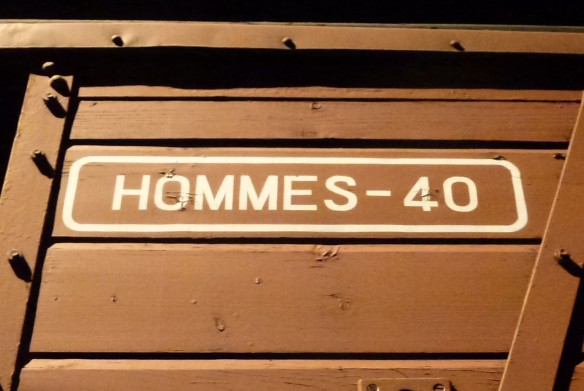I guess it could be said of me that I am like many men, in that I don’t normally show my inner emotions. Sure, I’ll go as bonkers as anyone when I’m at a sporting event and my team are doing well and yes I’m not slow in showing my displeasure if I feel that someone has done my family or I wrong! Other than that, no, don’t expect much else . . . normally.
Certainly the last place that I expected emotions to take hold of me would be in a railway museum.
It’s true that railways and locomotives have shaped much of my life, my late father was a mechanical engineer and much of my career involved actually running railways, you could say that it’s sort of in my blood and something that will never leave me! If I visit a museum like the fantastic Cité du Train in Mulhouse, I expect to be fascinated by the variety of exhibits, in awe of the craftsmanship that has made many of the locomotives and carriages and intrigued by the different operating equipment and practices. Only once have I been rendered numb by an exhibit and that occurred in Mulhouse.
The first hall of the museum is amazing. The different exhibits are each presented in atmospheric and dramatic pools of light, I loved it! The mood captures the drama of a night-time departure.
The efforts of the French Resistance movement in sabotaging the railways during World War Two.  . . . and of course lunch on the Orient Express!
. . . and of course lunch on the Orient Express!
Each exhibit has an audio-visual display that explains the details, what to look for and often the human stories associated, all very well done indeed.
In one dark corner I noticed a relatively small freight car and wandered over to take a closer look. It was the sort of vehicle that was used for carrying general cargo or even livestock, basically a simple ventilated box on wheels. Looking closer I noticed the stencilled lettering on the side of the car. I froze, stunned, shocked, appalled. I realised that I was looking at one of the vehicles used for the deportation of people during the dark Holocaust of World War Two. The stencil indicated that 40 people could be carried in this goods van of only 18 square metres area. In contrast, 8 horses could be carried instead.
I froze, stunned, shocked, appalled. I realised that I was looking at one of the vehicles used for the deportation of people during the dark Holocaust of World War Two. The stencil indicated that 40 people could be carried in this goods van of only 18 square metres area. In contrast, 8 horses could be carried instead.
I sat on a convenient bench and watched the accompanying audio/visual screen. The commentary detailed how the deportation of people was carried out by the occupying Nazi forces; the story was very factual and professionally done and although bereft of emotion the horror of what occurred was clear to see. Families torn apart, old, young and infirm pushed by rifle butts into the cattle wagons, photographs of despair and fear. Examples of hastily scribbled letters that the deportees threw from trains were highlighted. Of course most of these poor people were on one way journeys, to the horrific extermination camps at places such as Auschwitz where an estimated 1.1 million were murdered.
The video screen flickered to blackness as the presentation came to and end. I sat numbly looking at the blank screen for a few seconds, then glanced up at the simple wooden bodied freight car. 
In the darkness, I wept.

The whole museum looks designed to stun with its dramatic representation and lighting. Musuem should have the emotional power to take our breath away. I wonder if the freight carriage had been used in the First World War? I seem to remember reading about troops being similarly transported to the trenches in freight trains with the same markings in them. I must try and find a reference.
LikeLike
This particular wagon was built after WW1, so not this one. There is a similar, though larger vehicle, that dates from earlier and is showcased as a troop transport from the Great War. It also has a very interesting audio-vis display.
LikeLiked by 1 person
Oh goodness, that would have been hard to see I’m sure. I got chills just reading about it.
LikeLike
It took me by surprise, all I saw at first was a rather plain boxcar. Then the realisation of what I was looking at hit me and the depth of emotion that I experienced was overwhelming.
I have witnessed many unpleasant things in my life and unfortunately looked tragic death in the eye on too many occasions, but nothing could have prepared me for that dark corner of a railway museum.
Probably the most difficult thing to do was to sit down and write about it, as the feeling of the moment returned quite painfully.
I agree wholeheartedly with the comment made by Creaking Bones.
LikeLike
A part of history we must never be allowed to forget. Eternal vigilance is required to ensure horror on such a scale never occurs again.
LikeLiked by 1 person
I have tears in my eyes READING your post, I would have been right there crying beside you. Very moving Dookes.
LikeLike
I am blessed that so many people have empathised with me on this one. It took a while to decide to share it, but I’m glad I did. The moment was and still is very powerful.
LikeLiked by 2 people
I am glad you shared this story as well. We must never forget.
LikeLiked by 1 person
Thank you and you are correct, especially in our somewhat troubled times.
LikeLiked by 1 person